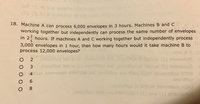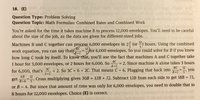GMAT QUESTION
- Thread starter Kamsam
- Start date
I find the given explanation obscure.
Start by naming things.
[MATH]a = \text {rate on machine A (in envelopes per hour}.[/MATH]
[MATH]b = \text {rate on machine B (in envelopes per hour}.[/MATH]
[MATH]c = \text {rate on machine C (in thousands of envelopes per hour}.[/MATH]
[MATH]h = \text {hours required for machine B to produce } 12,000 \text { envelopes.}[/MATH]
Any problem so far?
Four unknowns so we need four independent equations. We know that if rate is thousands of envelopes / hour, then rate times hours = thousands of envelopes.
[MATH]a = \dfrac{6}{3} = 2.[/MATH] Obvious.
[MATH]\dfrac{12}{5} * (b + c) = 6.[/MATH] Do you see where this came from?
[MATH]1 * (a + c) = 3.[/MATH] Should be obvious.
[MATH]h * b = 12.[/MATH] Obvious.
First solve for c.
[MATH]a = 2 \text { and } 1 * (a + c) = 3 \implies 2 + c = 3 \implies c = 1.[/MATH]
Now solve for b.
[MATH]\dfrac{12}{5} * (b + c) = 6 \text { and } c = 1 \implies \dfrac{12}{5} * (b + 1) = 6 \implies[/MATH]
[MATH]12(b + 1) = 30 \implies 12b = 18 \implies b = \dfrac{18}{12} = \dfrac{3}{2}.[/MATH]
And finally solve for h.
[MATH]h * b = 12 \text { and } b = \dfrac{3}{2} \implies \dfrac{3h}{2} = 12 \implies 3h = 24 \implies h = 8.[/MATH]
Start by naming things.
[MATH]a = \text {rate on machine A (in envelopes per hour}.[/MATH]
[MATH]b = \text {rate on machine B (in envelopes per hour}.[/MATH]
[MATH]c = \text {rate on machine C (in thousands of envelopes per hour}.[/MATH]
[MATH]h = \text {hours required for machine B to produce } 12,000 \text { envelopes.}[/MATH]
Any problem so far?
Four unknowns so we need four independent equations. We know that if rate is thousands of envelopes / hour, then rate times hours = thousands of envelopes.
[MATH]a = \dfrac{6}{3} = 2.[/MATH] Obvious.
[MATH]\dfrac{12}{5} * (b + c) = 6.[/MATH] Do you see where this came from?
[MATH]1 * (a + c) = 3.[/MATH] Should be obvious.
[MATH]h * b = 12.[/MATH] Obvious.
First solve for c.
[MATH]a = 2 \text { and } 1 * (a + c) = 3 \implies 2 + c = 3 \implies c = 1.[/MATH]
Now solve for b.
[MATH]\dfrac{12}{5} * (b + c) = 6 \text { and } c = 1 \implies \dfrac{12}{5} * (b + 1) = 6 \implies[/MATH]
[MATH]12(b + 1) = 30 \implies 12b = 18 \implies b = \dfrac{18}{12} = \dfrac{3}{2}.[/MATH]
And finally solve for h.
[MATH]h * b = 12 \text { and } b = \dfrac{3}{2} \implies \dfrac{3h}{2} = 12 \implies 3h = 24 \implies h = 8.[/MATH]
Dr.Peterson
Elite Member
- Joined
- Nov 12, 2017
- Messages
- 16,821
Are you saying you were taught the "combined work equation" but don't know how they used it, or are you asking what they mean by the "combined work equation", which appears to be something like [MATH]\frac{AB}{A+B} = T[/MATH]? I can tell you where it comes from, or I can tell you what they did if you tell us what you know about it.Can someone explain how the combined work equation was used in the answer?


